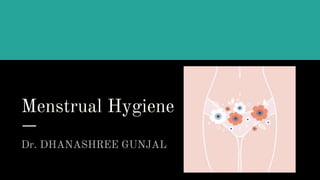Menstrual hygiene Dr. Dhanashree Gunjal
- 1. Menstrual Hygiene Dr. DHANASHREE GUNJAL
- 2. Periods!!! Its a ŌĆ£tabooŌĆØ topic??? ŌĆ£UncleanŌĆØ or ŌĆ£embarrassingŌĆØ
- 3. It is a natural process of our body.
- 4. Menstruation Menarche is an important biological milestone in a womanŌĆÖs life as it marks the onset of the reproductive phase of her life. The average age at menarche is mostly consistent across the populations, that is, between 12 and 13 years of age . Unfortunately, due to lack of knowledge on menstruation preparedness and management or due to shyness and embarrassment the situation becomes worse for girls A cyclical discharging of blood, secretions, and tissue debris from the uterus that recurs in nonpregnant breeding-age primate females at approximately monthly intervals and that is considered to represent a readjustment of the uterus to the nonpregnant state following proliferative changes accompanying the preceding ovulation.
- 5. Symptoms 1.Bloating 2.Breast swelling, pain or tenderness 3.Mood changes 4.Headache 5.Weight gain 6.Changes in sexual desire 7.Food cravings 8.Trouble sleeping
- 7. Menstrual myths ŌĆóEvery womanŌĆÖs cycle is or should be 28 days long. ŌĆóEvery woman will or should bleed every month. ŌĆóEvery woman will or should ovulate every cycle. ŌĆóIf a woman bleeds, she is not pregnant. ŌĆóA woman cannot ovulate or get pregnant while she is menstruating
- 8. What options are available? Cloth pads Menstrual cups Tampons Sanitary pad
- 9. Sanitary pads. ŌĆóSanitary pads can be used & disposed in a much easier way as compared to cloth. ŌĆóIt has absorbent material layer, which provides a dry feeling. ŌĆóDecreases chances of infections. ŌĆóHelps in mobility and ease of daily routine work. ŌĆóChange atleast once a day. ŌĆóChanging every 6-8 hrs is recommended. ŌĆóDuring heavy menses, may need to change every 3-4 hrs. ŌĆóDo not keep till completely soaked.
- 10. What if one uses cloth? ŌĆóEnsure that clean, soft, dry and absorbent cloth is used. ŌĆóIn case, it is being reused, it must be washed thoroughly and dried in private but sunny place. ŌĆóAfter drying, if possible it should be ironed, stored in a clean and dry place. ŌĆóDo not share this cloth with anyone. ŌĆóAfter multiple use, dispose off this cloth.
- 11. How to dispose sanitary pads? 1.Remove the used pad from your underwear and roll it up 2.Wrap the pad in a piece of paper. 3.Put the wrapped pad in the garbage can. 4.Wash your hands when you are done. 5.Take out the garbage bag with the used pad in it as soon as possible.
- 12. Potential risks to health of poor menstrual hygiene 1.Unclean sanitary pads- Bacteria may cause local infection or travel up the vagina and enter the uterine cavity. 2.Changing pads infrequently- Wet pads can cause skin irritation which can then become infected if the skin becomes broken. 3.Insertion of unclean material into vagina- Bacteria potentially have easier access to the cervix and the uterine cavity. 4.lack of handwashing after changing- Can lead to spread of infections such as Hepatitis B or Thrush.
- 13. How to keep yourself clean during periods? ŌĆóEveryday (morning and evening) wash your genitals with soap and water. ŌĆóKeep unused cloths and pads clean for further use. ŌĆóPat the area dry with a cloth and put afresh cloth, pad or tissue on your underwear. ŌĆóAlways wipe from front to back after defecation. ŌĆóNever douche (washing out the vagina with water)
- 14. How to manage the stomach pain from your period? ŌĆóYou can put a bottle with warm water on your stomach area when you are resting. ŌĆóTry to do some exercises and keep your body active. ŌĆóYou can take painkiller medicines every 4-6 hours on the most painful days.
- 16. Take time for yourself!!















